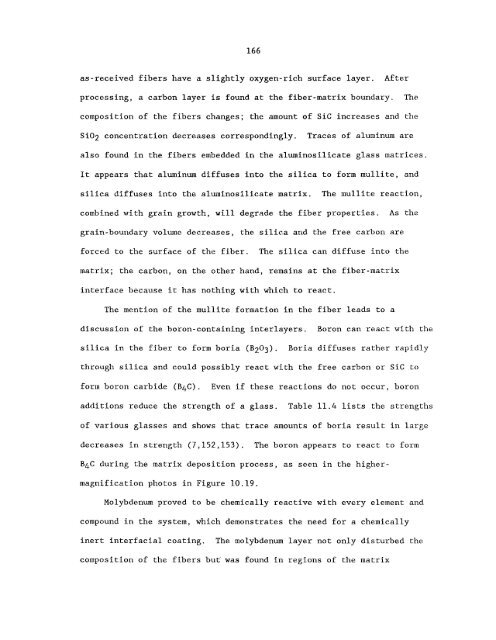Characterization and control of the fiber-matrix interface in ceramic ...
Characterization and control of the fiber-matrix interface in ceramic ...
Characterization and control of the fiber-matrix interface in ceramic ...
You also want an ePaper? Increase the reach of your titles
YUMPU automatically turns print PDFs into web optimized ePapers that Google loves.
as-received <strong>fiber</strong>s have a slightly oxygen-rich surface layer.<br />
After<br />
process<strong>in</strong>g, a carbon layer is found at <strong>the</strong> <strong>fiber</strong>-<strong>matrix</strong> boundary. The<br />
composition <strong>of</strong> <strong>the</strong> <strong>fiber</strong>s changes; <strong>the</strong> amount <strong>of</strong> Sic <strong>in</strong>creases <strong>and</strong> <strong>the</strong><br />
Si02 concentration decreases correspond<strong>in</strong>gly.<br />
Traces <strong>of</strong> alum<strong>in</strong>um are<br />
also found <strong>in</strong> <strong>the</strong> <strong>fiber</strong>s embedded <strong>in</strong> <strong>the</strong> alum<strong>in</strong>osilicate glass matrices.<br />
It appears that alum<strong>in</strong>um diffuses <strong>in</strong>to <strong>the</strong> silica to form mullite, <strong>and</strong><br />
silica diffuses <strong>in</strong>to <strong>the</strong> aluii<strong>in</strong>osilicate <strong>matrix</strong>. The mullite reaction,<br />
comb<strong>in</strong>ed with gra<strong>in</strong> growth, will degrade <strong>the</strong> <strong>fiber</strong> properties. As <strong>the</strong><br />
gra<strong>in</strong>-boundary volume decreases, <strong>the</strong> silica <strong>and</strong> <strong>the</strong> free carbon are<br />
forced to <strong>the</strong> surface <strong>of</strong> <strong>the</strong> <strong>fiber</strong>. The silica can diffuse <strong>in</strong>to <strong>the</strong><br />
<strong>matrix</strong>; <strong>the</strong> carbon, on <strong>the</strong> o<strong>the</strong>r h<strong>and</strong>, rema<strong>in</strong>s at <strong>the</strong> <strong>fiber</strong>-<strong>matrix</strong><br />
<strong><strong>in</strong>terface</strong> because it has noth<strong>in</strong>g with which to react.<br />
The mention <strong>of</strong> <strong>the</strong> mullite formation <strong>in</strong> <strong>the</strong> <strong>fiber</strong> leads to a<br />
discussion <strong>of</strong> <strong>the</strong> boron-conta<strong>in</strong><strong>in</strong>g <strong>in</strong>terlayers.<br />
Boron can react with <strong>the</strong><br />
silica <strong>in</strong> <strong>the</strong> <strong>fiber</strong> to form boria (B2O3). Boria diffuses ra<strong>the</strong>r rapidly<br />
through silica <strong>and</strong> could possibly react with <strong>the</strong> free carbon or Sic to<br />
form boron carbide (BqC), Even if <strong>the</strong>se reactions do not occur, boron<br />
additions reduce <strong>the</strong> strength <strong>of</strong> a glass.<br />
Table 11.4 lists <strong>the</strong> strengths<br />
<strong>of</strong> various glasses <strong>and</strong> shows that trace amounts <strong>of</strong> boria result <strong>in</strong> large<br />
decreases <strong>in</strong> strength (7,152,153). The boron appears to react to form<br />
B4C dur<strong>in</strong>g <strong>the</strong> <strong>matrix</strong> deposition process, as seen <strong>in</strong> <strong>the</strong> highermagnification<br />
photos <strong>in</strong> Figure 10.19.<br />
Molybdenum proved to be chemically reactive with every element <strong>and</strong><br />
compound <strong>in</strong> <strong>the</strong> system, which demonstrates <strong>the</strong> need for a chemically<br />
<strong>in</strong>ert <strong>in</strong>terfacial coat<strong>in</strong>g. The molybdenum layer not only disturbed <strong>the</strong><br />
composition <strong>of</strong> <strong>the</strong> <strong>fiber</strong>s but was found <strong>in</strong> regions <strong>of</strong> <strong>the</strong> <strong>matrix</strong>

















